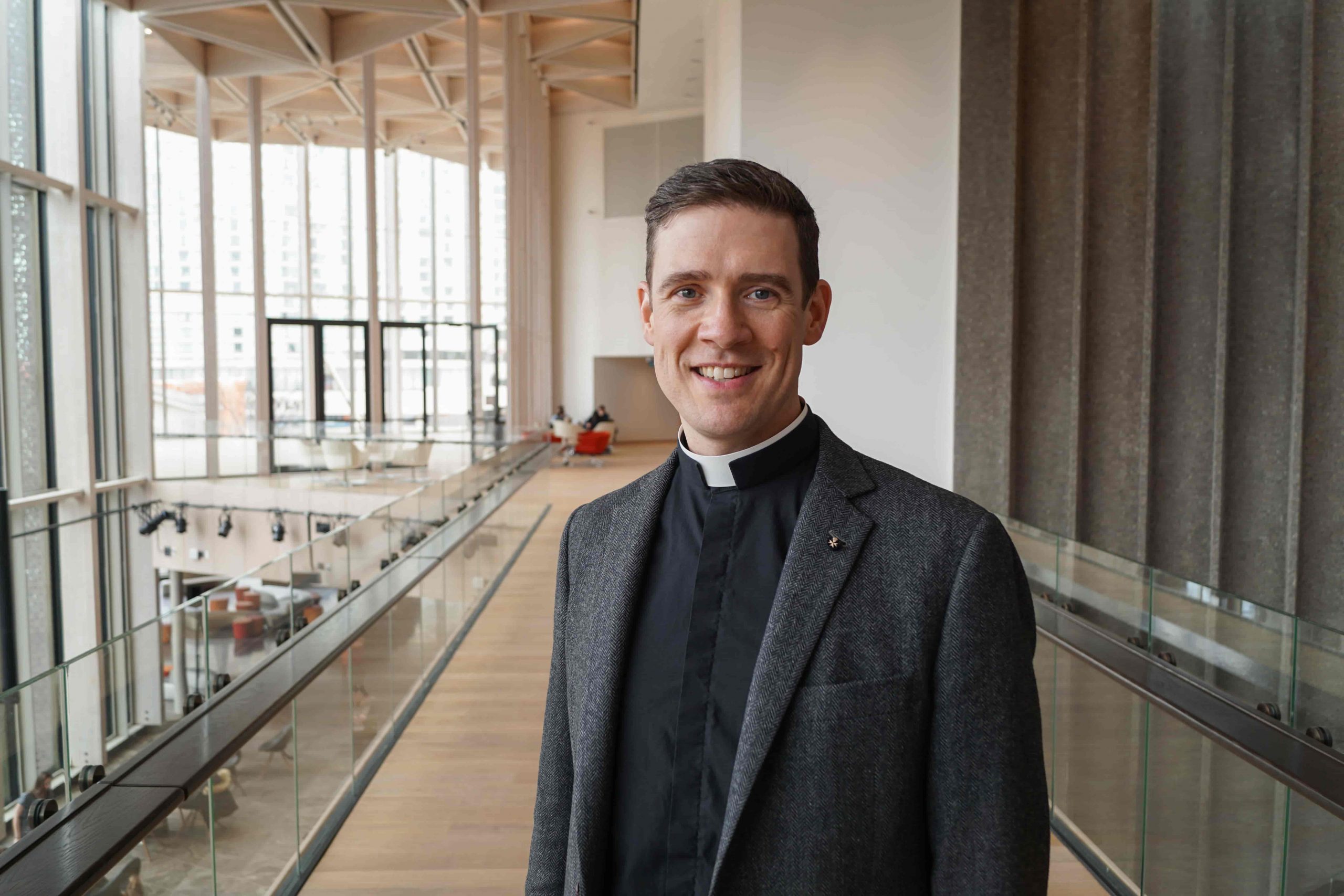Cardus is expanding its team and requires a full-time Communications Coordinator for our Hamilton, ON office. Applications will be accepted through July 8, 2013. Please forward this notice to interested parties. Full-time, salaried, contract (08/2013 - 03/2014) with the possibility of renewal. The application period is now closed.

Cardus Seeks Communications Coordinator
June 19, 2013

New Initiative Will Study Religious School Outcomes
NOTRE DAME, IN, May 23, 2013—Building on its groundbreaking studies into the citizenship outcomes of educational choice, Canadian think tank Cardus has partnered with the University of Notre Dame to establish a long-term education research initiative. The Cardus-Notre Dame initiative will formally launch in July 2013, with a mandate to explore how parental choice of religious school influences long-term student, family and community life. Ray Pennings, Cardus executive vice president, says the partnership is a result of the think tank's survey work in both the United States and Canada on how graduates of religious schools engaged in civic life once they entered adulthood. "Our surveys in 2011 (U.S.) and 2012 (Canada) were the first of their kind and provided a snapshot of what sort of citizens are being shaped by religious schools. The Cardus-Notre Dame Initiative is like turning the snapshot into a video of the long-term impact religious schooling is having," Pennings says. "This allows us to map the contribution various social institutions, including schools, make towards our shared life. It recognizes that belief systems play a vital role in how we act and think," he adds. University of Notre Dame sociologist Dr. David Sikkink, who will direct the research initiative and a staff of four researchers, said the primary goal is to provide the educational world with comprehensive, trustworthy data on the outcomes of religious schooling, and provide religious schools themselves with self-assessment tools. Cardus and the Notre Dame team will also host regular symposiums through the partnership. "The Cardus Initiative will design and conduct data analysis that addresses the question of why religious schools matter for particular student and family outcomes," Sikkink says. "By sorting out these mechanisms, the initiative will provide information to improve schools throughout the various religious school sectors and illuminate how these schools provide models for successful education." Cardus is a Canadian-based think-tank that has the renewal of North America's social architecture as its mission. The research initiative coincides with a growing profile for Cardus in engaging public conversations regarding faith in public life. In early May, it hosted a high-profile lecture featuring Bank of Canada Governor Mark Carney speaking on renewing trust in the financial system. It has also expanded its Social Cities program studying the relationship between municipal governments and faith institutions. For more information or to arrange interviews Ray Pennings and David Sikkink on the Cardus-Notre Dame initiative, please contact Julia Nethersole at 905-528-8866 ext. 29 or by email at jnethersole@cardus.ca.-30-
May 23, 2013

Statement to the Standing Committee on Transport, Infrastructure and Communities
On May 21, 2013, Brian Dijkema made the following remarks to the Standing Committee on Transport, Infrastructure and Communities in Ottawa, ON. See the briefing notes here.May 21, 2013 Good afternoon, ladies and gentlemen. It is an honour to be here, and I congratulate the committee for its work on the question of open tendering on federally funded infrastructure projects. I also wish to extend my gratitude for your work within the institutions of Canadian parliament and for your hard work representing Canadians across the country. My name is Brian Dijkema and I am program director for the work and economics research program at Cardus. Cardus is a public policy think-tank which has a long history of researching the role of construction in the Canadian economy, with a particular focus on how various forms of organizing labour impact the construction sector. I'd like to make two arguments today:First, "open tendering" and "closed tendering" are not equivalent to "non-union" and "union" construction. The sector is more complex than that. And second, the competitiveness and health of the construction industry now depend on an open and fair tendering process, not only for democratic reasons, but also for economic innovation in a sector Canada increasingly relies upon.On the first point, Cardus has several research publications charting the construction industry in Canada's economy from the 1970s to the present. One of the most profound changes in the sector during this time is the changing face of the way in which construction worked with labour. The construction industry labour force is unique because large-scale projects create large, cyclical demands for a specialized skilled workforce. There was a time when only the traditional craft unions were able to provide this labour and manage those cycles. That is no longer true. Today, a variety of labour pools exist, and work effectively in the industry. Many Canadian jurisdictions now have a "competitive labour pool" on the ground, but public policy has not yet developed to recognize this reality. A 2003 Cardus paper, Competitively Working in Tomorrow's Construction, noted the increasingly diverse character of construction workforce organization. Far from construction being neatly divided between just union and non-union shops, we noted that there were at least 7 different ways of organizing the workforce:traditional building trades craft unions, multiple crafts within one building trades union, craft unions which expand jurisdictions via multi-skilled tradespersons, the movement of maintenance unions into construction work, industrial unions such as the CEP taking on construction work, the development of alternative unions such as CLAC, and various unions organizing under project agreements.The binary presumption that work is organized either on a craft-union basis or an open-non-union basis is not an accurate portrayal of what is happening on the ground in the construction industry. This is an important shift, ladies and gentlemen: these different organizing models, and how they adapt to openness or restrictions across the spectrum, will define this industry in the medium term. In 2005, Cardus organized a "Stepping Forward" conference in Calgary, which brought together the full range of employer and labour organizations involved in this sector. The conference was co-sponsored by the Building Trades, Merit, CLAC, CLRA, and PCAC, all of whom came together to discuss the challenges facing the industry. The conference and subsequent report addressed a range of issues including labour supply, apprenticeship training, and quality of life as it applied to working models in the sector. Not only is there diversity within the organizing models present in construction, but the construction work force is increasingly national in its scope. We conducted two studies for the Construction Sector Council, Working Mobile (2005) and Working Local (2008) in which we surveyed construction workers regarding the motivations and obstacles that they faced in working in different jurisdictions. It became clear that there are a variety of barriers for workers that move across jurisdictions. A 2008 Cardus presentation to the Economic Club of Canada by my colleague Ray Pennings highlighted some of the economic dimensions of the challenge posed by the gap between policy and realities on the ground. Entitled "Why is Construction So Expensive In Ontario?," this paper highlighted the fact that Ontario's labour relations regime has virtually ignored the development of new models of organizing labour which are more prevalent in western Canada. This leads to my second argument. In Ontario especially, but also across the country, closed tendering practices are a key example of the outdated lag between policy and current realities. Ladies and gentlemen, Canada's construction organizing laws need to catch up to the better options available today. This will greatly help our economy, as public procurement budgets rise and rise. And it will bolster our democracy, as Canadian workers are looking for the freedom of choice traditional organizing no longer provides. Economically speaking, Cardus's Competitiveness Monitor has found that restrictive bidding adds up to a surcharge for public purchasers ranging from 2%—if you accept the model used by the city of Toronto and most frequently cited by representatives of those who tend to be the beneficiaries of a restrictive bidding model—to the City of Hamilton's estimate of 40%, which was provided to it by a consultant retained by the city when Hamilton was made subject to closed tendering. Stephen Bauld, who has authored legal texts on public procurement produced by Lexis Nexis, suggests that not only is the matter relevant in terms of who is eligible to bid and the cost strictures under which they operate, but that the number of bidders has an impact on the price. Bauld's research suggests that cost decreases range from 20-25% as the number of bidders rises from 2-15. Bauld suggests three reasons for greater competition in bidding. I quote:as the number of bidders increases, each participant in the process has an incentive to offer a better price, because it becomes harder for the bidders participating in the process to anticipate each other's behaviour. Second, a higher number of bids can increase the chance of receiving a bid from a party who will place a high value on securing the contract. Such a party is likely to offer the most competitive price. Third, an increase in the number of bids makes it more difficult for the bidders to organize on a collusive basis.1Closed bidding costs our public budgets immensely. And democratically speaking, there is a more fundamental argument. Disqualifying potential bidders from public works because of choices they make as private citizens runs contrary to Canadian principles. Closed tendering not only costs taxpayers more money, but it embeds one particular labour model to the detriment of other worker organizations. In short, it squelches the tremendous innovation and diversity taking place within the sector. Workers should be free to choose between these competing models of labour organizations without being arbitrarily disqualified from public works because of their choice. The public should also be able to benefit from the innovations that are taking place by seeing the full competitive range of qualified labour models competing for public work. There is an ancient principle on limiting sovereignty which says this: "That which touches all must be approved by all" (Guilielmus Durantis the Younger c. 1266-1330). I would suggest to this committee, and to the government, that a similar principle should be applied to tendering of publicly funded infrastructure projects. That which is funded by all, should be accessible by all. In other words, open tendering is about fairness. In a free and democratic society, there should be no restrictions which limit otherwise qualified companies from bidding on publicly funded work because of the private affiliations of their employees.I submit to this committee that the onus should not be placed on those asking for public tenders to be open to all Canadians, but on those who wish to close public tenders to a select group, whatever that group might be. What public policy goal is served when bidding is restricted? And this is not simply a municipal, or even provincial issue. It is a national issue. Significant amounts of federal funding are subject to closed bidding, including $263 million in Ontario alone according to our review of federal infrastructure expenditures. Union Station in Toronto, and the Pan Am Games Stadium in Hamilton, are two of the more high profile examples of this. In Manitoba, The Red River Floodway Expansion Project and the East Side Road Project are subject to project labour agreements with certain unions which effectively bar companies affiliated with other unions and non-union companies from bidding on public infrastructure projects under the labour relations model chosen by their employees. These projects have received over $324 million dollars of federal funding, and a significant portion of this work has been subject to restrictive project agreements. British Columbia too is structured in a manner that allows restricted worker choice and reduced competition. Unions there may "apply to the minister for the right to bargain collectively and enter into a project collective agreement for the duration of [major construction projects]." This effectively allows a given union to petition the minister for exclusive rights on major projects, politicizing public works in unhelpful ways.We recognize that there are significant interests at play in this discussion. My colleague, Ray Pennings, noted our 2003 Competitively Working paper that Given the significant dollars, organizational reputations, and market shares at stake for the various companies, unions, and associations involved in Canadian industrial construction, sorting through the spin is an inevitable necessity for any publicly held discussion about labour relations. Governments, including the federal government, have a significant task to sort through the spin and recognize that open tendering is a strategic concern for the country. It is connected to the heart of the country's jobs and training program. It will help engage diverse communities such as aboriginals. Open tendering will assist responsible resource extraction, and it will ensure that Canada's infrastructure deficit is brought back to surplus in an affordable and fair manner. This is a question of whether we'll live up to our reputation as a country which recognizes diversity, encourages innovation, and promotes excellence. As such, we have three recommendations:That the Minister of Industry commission a study to examine the cost savings which the federal government stands to gain from open tendering. That the government make reception of federal infrastructure funds conditional on opening public tenders to all qualified bidders, regardless of the labour affiliation of their employees, except in jurisdictions which are prevented by provincial law from doing so. That the government initiate meetings with its provincial counterparts to determine ways to ensure fair, open, and transparent bidding on projects receiving federal funds, with a particular emphasis on removing barriers to multiple labour pools.I thank you for your attention and welcome your questions. Brian Dijkema Program Director, Work & Economics bdijkema@cardus.ca | 905.528.8866 x23 NOTE:1. McGuinness, Kevin, & Bauld, Stephen; The Price Implications of Government Contracting Practices in the GTHA (Burlington, Ont.: Purchasing Consultants International, 2010).
May 21, 2013

Social Cities covered in <I>The Christians </I>
Paul Bunner writes about Cardus' Social Cities project. Program director Milton Friesen is discusses the Calgary City Soul project. To read the full article, click here.
May 16, 2013

Mark Carney Featured at Cardus Speaking Series in Toronto
MARK CARNEY FEATURED AT CARDUS SPEAKING SERIES IN TORONTO HAMILTON, April 26, 2013—Members of the media are invited to one of Mark Carney's last public appearances as governor of the Bank of Canada on Friday May 3, 2013 at the Toronto Region Board of Trade. Mr. Carney's brief introductory remarks will highlight a luncheon hosted by Michael Van Pelt, president of Cardus, and Father Raymond J. de Souza, editor-in-chief of Convivium magazine as well as a columnist with National Post and Catholic Register newspapers. Father de Souza and Roger Martin, dean of the Rotman School of Management, will offer their unique perspectives, and engage Mr. Carney in conversation on the ideas he has articulated as governor of the Bank of Canada. The event continues the Cardus' Hill Family Lecture Series that will include speakers such as Mr. Carney in Toronto, Barbara Kay in Ottawa, Conrad Black in Calgary, Rex Murphy in Vancouver and other notable Canadians in cities across the country. Mr. Carney will leave the Bank of Canada in June to become governor of the Bank of England on 1 July 2013. "Mark Carney is one of the superstars of international finance today, and it is a tremendous honor for Cardus and Convivium magazine to be able to offer him a forum for some of his farewell formal words to Canadians," Michael Van Pelt said. "To do that in a format where thinkers such as Father de Souza and Roger Martin can join him in a dialogue on the key economic issues facing all of us makes for a truly memorable moment." The program begins at 1:00 at 77 Adelaide Street West. Media representatives wishing to interview Michael Van Pelt or Father de Souza beforehand about the May 3 event or seeking more information on the Hill Family Lecture Series can contact Julia Nethersole at 905-528-8866 ext. 29 or by email at jnethersole@cardus.ca. Information is also available at www.cardus.ca. Cardus is a think-tank based in Hamilton, Ontario, which focuses on the renewal of social architecture in North America. Among its publications is Convivium magazine whose mission is to foster faith in our common life.-30-
April 26, 2013

Ray Pennings on “Manning Meets”
Cardus Executive Vice President, Ray Pennings discusses social architecture and the importance of engaging our institutions. To listen, click here,
April 22, 2013

Senior Fellow Jonathan Chaplin debates Alistair McBay of the National Secular Society
Hosted by the Edinburgh Solas Group, Cardus Senior Fellow Jonathan Chaplin debates the topic "A Secular Society: Should faith play an active role in public debate?" with Alistair McBay (National Secular Society). To watch the debate, click here.
March 5, 2013

Cardus Appoints New Comment Editor
185 Young Street Hamilton, ON L8N 1V9 Tel: 905.528.8866 Fax: 905.528.9433 info@cardus.ca www.cardus.caHAMILTON, December 5, 2012—Cardus Director of Research Ray Pennings announced today that Comment Magazine (www.cardus.ca/comment) will be served by new editor-in-chief Dr. James K.A. Smith beginning January 1, 2013. Smith, a highly regarded public intellectual, author, and professor, has been a long-time friend of Comment, regularly contributing and guest-editing the Spring 2011 issue. In accepting the appointment, Dr. Smith noted his excitement at being able to contribute to a magazine "that blends depth of analysis with breadth of audience, all with the goal of resourcing those committed to renewing the social architecture of North America." Smith teaches philosophy at Calvin College in Grand Rapids, Michigan where he also holds the Gary & Henrietta Byker Chair in Applied Reformed Theology and Worldview. A native of Embro, Ontario, he studied at Emmaus Bible College in Dubuque, Iowa; the University of Waterloo; the Institute for Christian Studies in Toronto; and earned his Ph.D. at Villanova University. He is a Visiting Professor at Trinity College of the University of Toronto and has also taught at Regent College, Fuller Seminary, Calvin Theological Seminary, and Reformed Theological Seminary in Orlando. Working at the intersection of philosophy, theology, and cultural criticism, Smith is an award-winning author of a number of books including Who's Afraid of Postmodernism? (Baker Academic, 2006), Letters to a Young Calvinist (Brazos, 2010), Desiring the Kingdom: Worship, Worldview, and Cultural Formation (Baker Academic, 2009), and Teaching and Christian Practices: Reshaping Faith and Learning, co-edited with David Smith (Eerdmans, 2011). His new book, Imagining the Kingdom: How Worship Works will appear in 2013 from Baker Academic. His writing has also appeared in a variety of magazines including Christianity Today, First Things, Books & Culture, Christian Century, and The Banner. Noted Pennings, "Comment reflects a vision that has only increased in relevance in the decade since we started publishing. In a post-Christian context, the challenge of providing thoughtful, rooted, yet fresh ideas that will build a Christian intellectual and culture-making community is daunting . . . and animating. We are confident that with Dr. Smith's leadership, we will be able to take Comment to the next level. Comment is available by subscription at www.cardus.ca/comment/subscribe. Online content also supplements the premier print material. Requests for interviews with Jamie Smith or Ray Pennings can be made by emailing Dan Postma, dpostma@cardus.ca, or phoning (905)528-8866 x28.-30-
December 5, 2012

Media Advisory: Labour Monopolies Cost Ontario Cities Millions
MEDIA ADVISORY: LABOUR MONOPOLIES COST ONTARIO CITIES MILLIONS HAMILTON, October 25, 2012—Labour monopolies increase costs for several Ontario municipalities by up to 10 per cent on nearly a billion dollars worth of Ontario construction projects, says a paper released today by Hamilton-based think tank Cardus. The study shows restricted public tendering affects 25 per cent of Ontario taxpayers-and puts significant pressure on already alarming municipal infrastructure deficits. A survey of 43 of the province's largest municipalities found Toronto, Hamilton, Sault Ste. Marie, and Kitchener are all subject to varying restrictions on the public tendering of construction projects. "That's a significant portion of Ontario's population but the real story is the amount of money affected," said Brian Dijkema, senior researcher in labour and economics at Cardus. "We're looking a baseline of two per cent in additional costs per year, and more likely in the 10 per cent range. When you consider we're talking about at least $750 million in construction projects, that's a lot of potential savings for cash-strapped municipalities." Dijkema said it's crucial to keep in mind that those costs accumulate year over year, adding to the burden of municipal infrastructure deficits. The study concludes a key solution is competitive bidding processes for construction projects in these municipalities. "For a city like Toronto, which spends billions every year on construction while at the same time fighting over budget cuts of $19 million, competitive bidding could be a boon to the bottom line," Dijkema said. "Schools and other major crown corporations could add similar savings; this is just the tip of the iceberg." The paper is the first of a series of studies, dubbed the Cardus Construction Competitiveness Monitor, which will examine the impact of labour monopolies on public entities from municipalities to school boards and major public corporations. The next paper, studying the impact of restricted bidding on Ontario school boards, will be released later this fall. The full version of "Cardus Construction Competitiveness Monitor: Ontario Municipal Construction Markets" can be downloaded at http://cardus.ca/go/ch. Requests for interviews with Cardus researcher Brian Dijkema can be made by emailing Julia Nethersole, jnethersole@cardus.ca, or phoning (905)528-8866 x29. -30-
October 25, 2012



